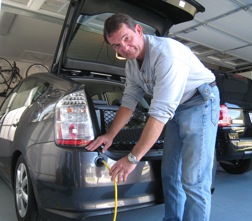If the electric car was indeed “killed,” as a popular documentary suggested not long ago, the floor at the Los Angeles Auto Show this week would suggest a mass resurrection not seen since Night of the Living Dead. Climate Watch contributor Alison Hawkes reports on some implications for the power grid. Her radio report airs Friday on The California Report.
By Alison Hawkes
Electric vehicles may be few in number over the next few years, despite the hype around the release of off-the-assembly line EV models in 2010. It takes several decades to flip the American vehicle fleet.

But there’s little doubt that EVs are coming, pushed on by anxiety over foreign oil and unexpected spikes in gas prices, growing environmental awareness, and government incentives. Starting at the end of December, EV buyers get a federal tax credit of between $2,500-to-$7,500 per vehicle, depending on the battery size. There are other tax credits for plug-in conversions and even electric motorcycles and electric three-wheelers. Now who doesn’t like a tax credit?
All this may sound promising but energy planners have some serious head-scratching to do as Americans begin switching their transportation fuel from gasoline to electricity.
For starters, how do you avoid building extra power plants? Who pays for infrastructure upgrades to electrical substations and transformers? How do you get EV drivers to charge during off-peak hours when the energy supply is now wasted?
Pacific Gas & Electric’s smart grid director Andrew Tang says utilities have faced similar problems before with the advent of air conditioners in the 1970s and plasma screen TVs in the 1990s. New technologies add to the demand on an already tight energy market. “It’s a form of load growth and we’ve managed to deal with it without having sudden power outages,” says Tang.
But, Tang admits, EVs could bring a heavier strain on the grid than any seen before. One EV can draw as much energy as a house. Put another way, that’s doubling a household’s demand for power. Fortunately, it sounds like the utilities have some time, and capacity, to see how the EV market develops.
PG&E is expecting to support some 250,000 vehicles by 2020, which may not seem like much for a 70,000 square-mile service territory. But they won’t be spread out evenly. The northern California utility is expecting EV drivers to congregate in certain neighborhoods, potentially sending substations and transformers into overload (read: blackouts) if not properly managed. Tang said PG&E did a study of hybrid electric vehicle registration over the last four years and found that Fresno’s portion of hybrids was 2.4 percent, while Berkeley’s was 18 percent. “That’s much more concentration,” says Tang. “We think that’s a fair proxy of what we could have with electric vehicles.”
So the California Public Utilities Commission is now exploring ways to regulate EV’s. The basic question is how to influence consumer behavior so EVs do not add to peak energy demand. No one wants blackouts, and no one wants to build more power plants. One idea bandied about is a differentiated rate system that encourages EV drivers to charge during off-peak hours at deeply discounted prices, called a “time of use rate.” Another idea promoted by the PUC’s independent Division of Ratepayer Advocates is a five-dollar monthly fee on EV drivers that would go into upgrading grid infrastructure, like adding or upgrading local transformers, as needed.
“If electric vehicles need (additional) infrastructure, they should pay for it and not spread the cost across all ratepayers,” says DRA’s deputy director Dave Ashuckian.
EV drivers may bristle at being treated differently than other power users, especially when they feel they’re doing society a favor by switching to a cleaner fuel source. Early adopters may be happy to help optimize the grid. But if EVs go mainstream, energy planners know the public is going to want a more convenient system.
Automated smart metering (you’re not in charge of your charging) may help. The hybrid plug-in Chevy Volt coming next year is supposed to come with a smart meter. But planners eventually foresee public charging stations that will allow EV drivers to juice up quickly (through high-wattage charging equipment) and when they need to, during daytime peak hours. Already some California companies that want in on the emerging charging station business are fighting the idea of PUC regulation of their potential market.
A California PUC staff white paper reported that the benefits of lowered greenhouse gas emissions with an electrified transportation system are realized only when some 76 percent of EV drivers charge off-peak. And only if any extra power demand is met by renewable energy sources – not coal or oil. That’s a tall order.
Ed. Note: One thing EV’s already have going for them: a lobby. This week it was announced that after 16 years, deputy director Eileen Tutt is leaving CalEPA to become executive director of the California Electric Transportation Coalition.
